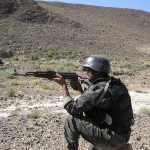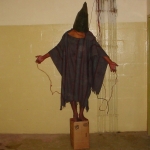Border for Sale
Privatizing Immigration Control

Five major military contractors are competing to design a system to tackle up to two million undocumented immigrants a year in the United States. Boeing, Ericsson, Lockheed, Northrop Grumman and Raytheon are working on proposals that focus on high technology rather than high fences, but ignoring some of the fundamental problems of immigration.
At each checkpoint along the path to citizenship or deportation -- from desert wilderness to urban labyrinth -- private contractors are expected to be hired to detect, apprehend, vet, detain, process, and potentially incarcerate or deport people seeking economic and human rights asylum in the U.S.
An indefinite delivery, indefinite quantity (IDIQ) contract, estimated at $2.5 billion, for the Secure Border Initiative Network (SBInet) will be awarded September 30th 2006, to build a seamless web of new surveillance technology and sensors with real time communications systems for Customs and Border Protection (CBP). The plan also includes funds for additional personnel, vehicles and physical infrastructure for fencing, and virtual fencing for U.S. borders.
The new contract is part of the $43.5 billion Homeland Security (DHS) budget for 2007, with up to 20 percent increases in areas of internal enforcement and border protection. This has brought new fervor to the domestic security industry. Security executives around the country are pulling late hours preparing proposals and bids that will cost billions in federal tax dollars.
Border Watch: Our Ongoing Coverage Fencing the Border: Boeing's High-Tech Plan Falters The Life and Death of a Border Town This Alien Life: Privatized Prisons for Immigrants |
SBInet is part of a new Bush administration plan, announced in November 2005, for border security aimed at stopping illegal immigration along the more that 6,000 miles that make up America's land borders and dealing with the millions of undocumented aliens already in the country. While President Bush has said that "mass deportation is unrealistic," DHS is nonetheless ramping up CBP's "Expedited Removal Program" to detain and remove 1.5 million people along the border and the additional half a million apprehended 100 miles within US territory, according to the CBP and other agencies. Migrants who make it past the 100 mile mark and manage to stay 14 day without being caught are entitled to a hearing before a federal immigration judge.
The privatization of border security is unprecedented not only in cost but in the extent to which the federal government is ceding control to private companies.
"We're asking you to come back and tell us how to do our business. We're asking you. We're inviting you to tell us how to run our organization," Deputy Director of Homeland Security Michael Jackson told more than 400 defense contractors and homeland security industrialists at a government-sponsored "Industry Day" on January 25 this year. Jackson, a former Lockheed Martin vice-president, added: "This is an invitation to be a little bit, a little bit aggressive and thinking as if you owned and you were partners with the CBP."
| The Chariot Race The competition between the five prime bidders for SBInet might be viewed as a chariot race: Each prime contractor will drive the chariot; the horses will be its team of small and large, mid-range and small companies. The chariot itself, the wheels and axles are Americans' security. The competition is supposed to crown the driver that can deliver the best value for the tax dollar. Quick coalitions of vendors were formed with the help of homeland security brokers to meet the May 30 deadline for completed bids. Team building continues and Lockheed Martin made a special effort to develop a diverse one. After SBInet's Industry Day in January, it held its own "Vendor Industry" days in Seattle, Buffalo, and Washington DC. It also went shopping for local domestic security providers in El Paso, Laredo, Tucson, and San Diego. The outcome of this is secret: Lockheed has kept its cards closest to its chest in the pre-award period, choosing not to reveal its core team of companies. But the other four potential prime contractors have announced their teams: Boeing Integrated Defense Systems will join with DRS Surveillance and Kollsman, Government Services Incorporated (an L-3 subsidiary), Perot Systems, Reconnaissance Group and Unisys Global Public Sector. Boeing is the world's largest satellite manufacturer, and George Muellner, president of its Integrated Defense Systems business unit, cites its experience developing and deploying large-scale systems as a special qualification. The Northrop Grumman team members announced so far are Anteon International, BearingPoint, General Dynamics, HNTB Corporation, L. Robert Kimball and Associates, Titan (an L-3 subsidiary), and SRA International. Raytheon boasts that it is the only firm with experience monitoring a large geographic area such as the US-Mexico and US-Canadian borders. It also runs a 2 million square mile program in Brazil called System for Vigilance of the Amazon (SIVAM). Raytheon's core team is comprised of Apogen Technologies, BAE Systems, Bechtel National, Deloitte Consulting LLP, IBM, and 30 subcontractors, including Accenture. Ericsson's team includes AEP Networks, America's Border Security Group, Camber Corporation, Computer Sciences Corporation, Fluor, MTC Technologies, Sy Coleman (an L-3 subsidiary), Texas A&M University, and the University of Texas at Austi |
Indeed his former company is one of the leading bidders for the contract. "We're expecting quick proposals on quick timelines," Keith Mordoff, a Lockheed Martin spokesperson told CorpWatch. One of the 50 largest companies in the U.S., the Maryland-based corporation has more than 100 executives working on the Secure Border Initative according to Mordoff. Four other corporations: Boeing, Ericsson, Northrop Grumman and Raytheon; are vying for the same SBI slice of the DHS budget pie. Each of these rivals has between 70 and 100 executives assembling security teams and designing the replacement for America's Shield Initiative.
High Walls versus High Tech
A few believe that high walls and fences are the answer like U.S. Republican Congressman Steve King from Iowa. Scale model in hand, he took the floor of the House of Representatives on May 24 with a hard-sell for a fence. "A little company like I used to own before I came to this Congress, and [that] my son operates today, could set a mile of this in a day pretty easily. . . .We are spending $8 billion on 2,000 miles. That is $4 million a mile. Now, if you pay me $4 million for a mile of that desert down there and say, guard that mile, Mr. King, I would say, for $4 million, you would not get a cockroach across that border."
But most of the proposals rely on high-technology rather than high fences. Sensor Technologies and Systems of Scottsdale, Arizona has already been recruited to join three of the prime contractors' teams. It sells a ground radar system that has been used in the conflict-ridden West Bank and has been proposed for environmental projects in protected areas such as Organ Pipe Cactus National Monument and Cabeza Prieta Wildlife Refuge.
Walker Butler, the owner of Sensor, says physical fences would end up being more expensive: "Bottom line is that a fence would cost at least 10 times the radar system--including everything required--cameras, poles, power, communications. And it [a fence] would be much less effective."
Another key component of the several proposals are plans to use remotely controlled aerial surveillance technologies to reduce the use of expensive and unwieldy helicopter monitoring: Northrop offers its own unmanned aerial vehicle, the Global Hawk drone, as a challenge to Lockheed Martin's $14 million high-altitude surveillance blimp. Yet another potential sub-contractor, Octatron, offers an urban mini-drone with a six-foot wing-span with video and transmission equipment weighing just three pounds.
(The Octatron's urban mini-drone was recently temporally downed in Los Angeles by a prospective civil rights suit against Los Angeles Policy Department for violating privacy laws. But it should qualify for the competition in urban border cities San Diego, Mexicali, Nogales, Las Cruces, Juarez, El Paso, Laredo, and Brownsville.)
Bruce Walker, Northrop Grumman's director of homeland security, says that they will combine high-tech gizmos with trained personnel and planning to keep migrant labor from finding a way to the U.S. According to Walker, Northrop offers "the layered approach that is needed to secure the border. If wind or vandals take out cameras, back-up surveillance will be in place."
"We need operational control of the border. We want to push the immigrants into lanes that conforms with our ports of entry."
Doug Smith, head of Ericsson's Solutions agrees with DHS deputy director Jackson and industry experts. "This is not just about sensors and the coolest new UAV. Wireless communications is big. We think we can solve this with existing personnel today with the right tools." Smith envisions Border Patrol agents being able to send digital fingerprints of apprehended immigrants right from the desert floor to central locations and field offices. He is confident that Ericsson could leverage resources at all levels, from detection, apprehension to deportation. "We'll drive the buses, and handle everything."
Will They Work?
But underlying much of the debate over what kind of fence and how many high-tech gizmos will be needed to seal the border are more fundamental questions about the complex issue of illegal immigration. Experts note that given the demand for cheap labor in the U.S. and the poor prospects of economic development in much of the world, the solution will have to go higher than fences and wider than radar.
In March this year, Michael Chertoff, the head of the DHS, bluntly accessed the efficacy of barriers when he told a Senate committee, "They'll just go around a fence."
By Immigration and Customs Enforcement's (ICE) own estimates, half the country's undocumented workers enter the United States legally with temporary visas that they overstay. Voluntary departure orders have simply not worked so internal enforcement relies on ICE operations teams and the Office of Detention and Removal.
This too is being privatized: DHS has allocated $410.2 million in its 2007 budget for Detention and Removal to expand existing facilities, and new detention capabilities in the event of an immigration emergency, a contract awarded to Halliburton of Houston, Texas, a company formerly headed by U.S. Vice-President Dick Cheney.
No Border between Government & Industry
Should Lockheed Martin win the SBInet contract, it will be difficult to avoid speculation that it had an inside track because former Lockheed Martin executive Jackson is Secretary Chertoff's right-hand man in the Secure Border Initiative.
But Lockheed argues that other advantages put it in the lead. Lockheed is "the only team that can leverage and apply lessons from a long list of successful programs to offer DHS integration experience not available from any other supplier," says company spokesperson Keith Mordoff. That experience includes programs in Border Security solutions, Biometrics, Transportation and Security solutions, Critical Infrastructure Protection, and Emergency Response and Management."
Asked about past performance touted in its proposal, spokesman Mordoff told CorpWatch that the company would "rather keep the competition guessing on what past programs we might be highlighting."
Yet Lockheed is by no means alone among the five contractors in having friends in high places: no fence, virtual or physical, seems likely to separate corporations from the Washington trough.
Investigative journalists have already uncovered examples of potential conflict of interest. Eric Lipton's two-part New York Times report ("Homeland Security Inc." June 18-19, 2006) reveals the dizzying velocity of the revolving door between DHS and the private domestic security industry. He lists nearly 100 former DHS and White House executives who have migrated toward magnet jobs with domestic security consulting, investing, and lobbying firms.
Exposés by the Washington Post's Robert O'Harrow ("The High Price of Homeland Security") describe a path to border security, citizenship and mass deportation that will be lined with pork for some of the GOP's most loyal supporters. His December 25, 2005 report with Scott Higham "Post-9/11 Rush Mixed Politics With Security," exposed a Kentucky Republican Congressman Harold Rogers' contributions from homeland security contractors. These companies - Reveal, NucSafe, Datatrac Information Services, and Science Applications International Corporation - all opened offices in Rogers' district once he became chairman of a key budget committee in Congress, then went on to receive sizable DHS contracts.
In the American Prospect, Sarah Posner's "Homeland Security for Sale," followed millions in DHS money by tracking the activities of the Philadelphia-based lobbyists Blank Rome LLP. Blank Rome chairman David Girard-diCarlo hired DHS officials Mark Holman, Carl Buchholtz and Ashley Davis, who worked closely with former DHS Secretary Tom Ridge. Blank Rome partner David Norcross also chaired the arrangement committee at the Republican National Convention in 2004.
Listen to an interview with author, Joseph Richey.



